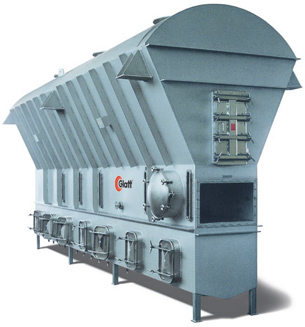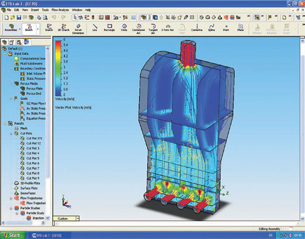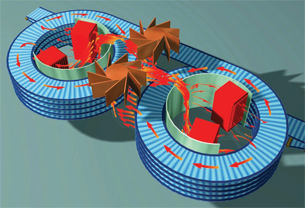Embedded FloEFD Puts Food On the Table
Processing food, from mixing to baking, can present some complex problems best handled by computational fluid dynamics.
Latest News
November 1, 2008
By Ivo Weinhold
 Figure 1: The Glatt continuous fluidized bed coating apparatus helps create nutritional supplements for products like granola bars. |
Fluid flow plays a major role in the vast majority of food processing applications. Computational fluid dynamics (CFD) provides the ability to simulate fluid flow on a computer, providing the potential to solve problems and optimize processes to a much higher level than is possible with traditional build-and-test methods. But the complexity and cost of using CFD has, until recently, largely limited its usefulness to a few food processing and equipment companies with the large engineering budgets needed to lease expensive software and hire analytical specialists that have the required training and experience.
Less expensive CFD codes now exist that are embedded into computer aided design (CAD) software already used by food industry engineers to design processing equipment. One example is FloEFD from Mentor Graphics (formerly Flomerics), which, when installed with SolidWorks, embeds itself into SolidWorks. Software packages like this greatly simplify CFD simulation by using native 3D CAD data, automatic meshing of the flow space, and managing the flow of parameters as object-based features. The new embedded CFD tools have the potential to bring the benefits of CFD to nearly every company involved in food processing.
Importance of Fluid Flow in Food Processing
For example, fluid flow plays an important role in mixing applications. In designing static mixers, the mixing quality improves with the number of elements as well as the amount of power used to pump fluids through the mixer. Ovens are another challenging fluid flow application. It takes a lot of time and expense to experiment with different oven configurations in an effort to provide the velocity or temperature profiles needed by a product.
CFD provides a powerful tool to address applications such as these, and can be used to create a virtual prototype of the product or process that closely models the behavior of real-world conditions. The simulation results typically include predictions of the flow velocity, temperature, and species concentration at any point in the simulation domain. Once the initial model has been created, the engineer can easily make changes to the equipment design or process conditions to investigate a wide range of design alternatives.
Fluidized Bed ApparatusEmbedded CFD Simulation
The process engineering department of Glatt Ingenieurtechnik in Weimar, Germany, uses embedded CFD to improve the design of food processing equipment. The company produces fluid bed coating equipment in which particles are fluidized, then sprayed with coating fluid and dried. Small droplets and the low viscosity of the spray medium ensure even product coating. This process is used, for example, to prepare sources of omega-3 fatty acids by converting them into a powder for inclusion into a nutrition bar. Michael Jacob, who is responsible for process engineering and development, said the company’s engineers were quickly able to learn and use embedded CFD software. “The software can be learned incredibly fast,” Jacob said. “All you need to know is the basics.”
 Figure 2: This is a simulation of the fluidized coating apparatus creating powdered fatty acids. |
Glatt uses embedded CFD to design fluid bed units for customers’ specific requirements. “We have to be able to react flexibly to customer requirements,” Jacob said. “This means that every machine is designed for the needs of a specific application. The units are relatively large and have to be rated for pressure and temperature. The result is that flow conditions are substantially different in each machine. We calculate the additional data we need with our own software and then integrate the data as a volume source in the embedded CFD simulation. We use the flow simulation results in the design and in the strength calculations.”
Recently, Glatt designed a new spouted bed unit that sprays a solution or suspension that contains solids in dissolved form onto the fluidized particles. The particles are agglomerated — or granulated — to produce free flowing instant products or uniform dense pellets. Process engineers began by using SolidWorks CAD software to create a basic model of his initial concept design. Technicians built a lab and a pilot-scale prototype of the initial design of the new machine. The spouted bed pilot-unit occupies 0.2 square meters compared to 1 to 10 square meters for the production machines.
CFD software was used to simulate the lab and pilot prototype. The lab scale prototype was built with a glass wall so that the flow patterns inside could be visualized and compared to the CFD results. After a few minor adjustments, the CFD predictions matched the performance of the prototype. The usefulness of the prototype in the design process is limited because the scale-up from lab to pilot to production is nonlinear. However, once Jacob had tweaked the CFD model to accurately predict the performance of the pilot plant he was then able to scale the CFD model up to the size of the production plant with confidence in its results.
The CFD simulation of the production-scale model showed recirculation zones in the upper part of the fluidized bed chamber. Jacob tried addressing this problem by changing the position and size of the outlet air tubes. The simulation results showed that the outlets had major effects on the air distribution. By changing their size and position, he eliminated the recirculation zones. Jacob then added particles to the flow field in different sizes and checked the size of particles entrained in the airstream. In this application, certain particle sizes need to be entrained in the outlet stream while other particles are left to circulate in the chamber. Jacob further adjusted the outlets to optimize airflow and particle distribution. Once he was satisfied with the performance of the fluidized bed, Jacob started looking at energy consumption. He adjusted the inlet air chamber in the model to reduce pressure drop. That made it possible to reduce the size and power consumption of the fan while also increasing process stability.
 Figure 3: This is a FloEFD hot air oven simulation. |
The process engineers then turned the optimized design over to the mechanical engineers responsible for producing the detailed design. When that was completed, one additional iteration is tested to ensure that minor changes made during the detailed design process had no negative impact on performance. The resulting design provides gentle handling of temperature-sensitive materials at throughputs ranging from 10 kg per hour to a few tons per hour.
“The direct coupling of the CAD system and CFD simulation greatly reduces the amount of time required to optimize the design,” Jacob said. “We have been following this same process whenever we launch a new machine or tune an existing machine to a new customer application. With CFD we can eliminate two or three prototype stages and cut development time in half. Most important, we can evaluate more design iterations so we can optimize the performance of the machines to a higher level than was possible in the past.”
Baking Oven Simulation
Another user of embedded Flomerics in the food industry is Stork Food Systems. They are a major supplier of food processing equipment, including hot air ovens to steam, cook, or grill meat, fish, ready-meals, and the like. Its latest development is an oven with two zones. The oven air can be humidified with steam from a single actuator. For an improved design of the steam supply piping, the distribution of steam over the two zones had to be verified. After some rough calculations by hand, CFD was used to analyze the performance of a few proposed designs. These designs were modeled in CAD and then prepared for the CFD analysis. As originally intended, the project was cloned to change boundary conditions only and assess their impact. In the example at hand, the CFD analysis confirmed the manual calculations and also provided more detailed results. The best design was easily selected.
CFD offers the potential to streamline the design process by making it possible to evaluate a wide range of oven designs simply by changing the geometry or process conditions of the model. Up to now, limitations in conventional CFD software have caused CFD to be used only by a few major food processors and equipment manufacturers. The new generation of embedded CFD software greatly reduces the cost and time required for food processors and equipment manufacturers to perform flow simulations, making it much more practical for the vast majority of food processors and equipment manufacturers to create detailed predictions of fluid velocity, pressure, and temperature to gain a better understanding of the process, optimize designs without building many prototypes, and getting to market with a better product in less time.
More Info:
Mentor Graphics Mechanical
Analysis Division
Marlborough, MA
SolidWorks
Concord, MA
Ivo Weinhold is the mechanical CFD business manager for Mentor Graphics. He has a master’s degree in mechanical engineering and a Ph.D. in medical sciences. To comment on this article, send an e-mail to [email protected].
Subscribe to our FREE magazine, FREE email newsletters or both!
Latest News
About the Author
DE’s editors contribute news and new product announcements to Digital Engineering.
Press releases may be sent to them via [email protected].






